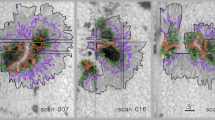Abstract
Hydrostatic models of sunspot penumbra and umbra are evaluated using Bode's tables of monochromatic absorption coefficients andT-τ-relations given by Makita and Morimoto (1960) and by Zwaan (1965). These models are placed side by side to simulate a complete sunspot corresponding to an area of 480×10−6 of a hemisphere. Intensity profiles are evaluated for aspect angles up to 85° and compared to observations. The primary aim was to study the influence of spot transparency, which is closely related to the gas-pressure, on the Wilson-effect and on other changes in the intensity profile that appear close to the solar limb. The gas-pressures at the zero-level in the geometrical depth (z=0) corresponding to optical depth, τ=10−3, both in the umbra,P u0 , and in the penumbra,P p0 , appear as adjustable parameters.
When curvature is taken into account, the Wilson-effect cannot be reproduced without depressing the zero-point in the geometrical scale in the umbra relative to the same layer in the photosphere. A depression of 400 km will give a reasonably good fit for the Wilson-effect providedP u0 <P P0 <P Ph0 . The model we found to give the best fit is based on Makita and Morimoto'sT-τ-relations withP P0 =3200 andP u0 =800.
We have here chosen an umbra pressure that gives a small limb-side intensity peak at the penumbra border, assuming that the bright points described by Bray and Loughhead (1964) may be interpreted in terms of a transparency effect.
Other parameters measured by Wilson and Cannon (1968) are evaluated, and for some a good agreement was obtained, while for others only a qualitative effect in the same direction could be found.
Surfaces along which the optical path is constant (isodiaphanous surfaces) are functions of aspect angle and well suited for visualizing the transparency in spots.
It is shown how for a wide range of models the isodiaphanous surfaces get asymmetric close to the limb. This has consequences for the interpretation of the Evershed-effect. In fact, under certain conditions, a ‘masking’ effect may take place because the greater transparency in the penumbra will allow observations of a deep laying flow, which will not be visible through the more opaque photosphere. Due to the asymmetry this effect is different on the limb side and the center side.
We also found the spot to show an apparent displacement away from the limb, which at a heliocentric distance of 85° amounts to about one second of arc. Intensity profiles in the near infrared at 8206 Å and at 16482 Å are evaluated, and the importance of observations in these spectral regions is emphasized.
Similar content being viewed by others
References
Bode, G.: 1965,Die kontinuierliche Absorption von Sternatmosphären in Abhängigkeit von Druck, Temperatur und Elementenhäufigkeiten, Kiel.
Beckers, J.: 1966,Proc. Meeting on Sunspots, Florence, p. 186.
Brahde, R.: 1964,Astrophys. Norvegica 9, 199.
Bray, R. J. and Loughhead, R. E.: 1964,Sunspots, Chapman and Hall Ltd., London.
Chistyakov, V. F.: 1962a,Soviet Astron.-AJ. 5, 471.
Chistyakov, V. F.: 1962b,Soviet Astron.-AJ. 6, 363.
Chitre, S. M. and Shaviv, G.: 1967,Solar Phys. 2, 150.
Deinzer, W.: 1965,Astrophys. J. 141, 548.
Jensen, E.: 1958,IAU Symposium No. 6 (Stockholm), 258.
Jensen, E. and Maltby, P.: 1965,Astrophys. Norvegica 10, 17.
Jensen, E. and Ringnes, T. S.: 1957,Astrophys. Norvegica 5, 259.
Kjeldseth Moe, O. and Maltby, P.: 1969,Solar Phys. 8, 275.
Makita, M.: 1963,Pub. Astron. Soc. Japan 15, 145.
Makita, M. and Morimoto, M.: 1960,Pub. Astron. Soc. Japan 12, 63.
Maltby, P. and Eriksen, G.: 1967,Solar Phys. 2, 249.
Maltby, P. and Mykland, N.: 1969,Solar Phys. 8, 23.
Mattig, W.: 1958,Z. Astrophys. 44, 280.
Michard, R.: 1953,Ann. Astrophys. 16, 217.
Pierce, A. K. and Waddell, J. H.: 1961,Mem. Roy. Astron. Soc. 68, 89.
Schröter, E. H.: 1962,Z. Astrophys. 56, 183.
Staveland, L.: 1968, Private communication.
Wilson, P. R.: 1968,Solar Phys. 3, 243.
Wilson, P. R. and Cannon, C. J.: 1968,Solar Phys. 4, 3.
Yun, H. S.: 1968,Theoretical Sunspot Models, Thesis, Indiana University.
Zwaan, C.: 1965,Rech. Astron. Obs. Utrecht 17, Part 4.
Author information
Authors and Affiliations
Rights and permissions
About this article
Cite this article
Jensen, E., Brahde, R. & Ofstad, P. The wilson effect and the transparency of sunspot models. Sol Phys 9, 397–419 (1969). https://doi.org/10.1007/BF02391663
Received:
Issue Date:
DOI: https://doi.org/10.1007/BF02391663




